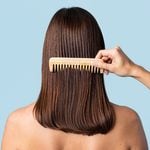Everything You Need to Know About Female Hair Loss
Up to 40 percent of women will have some degree of hair loss over their lifetime. Here are the best solutions for maintaining healthy locks.

Research shows that we typically lose up to 100 hairs a day as our follicles go through constant cycles of growing, resting and shedding.
But some women may begin to notice more hair than usual falling out, especially as they get older. The most common reason for hair loss typically occurs after menopause and is called female pattern baldness. “Female” is key here, because the pattern differs from males. While men may find their front hairline receding, for women, hair loss shows up as a widening of the centre or side part, or an overall thinning that reveals more scalp on the crown. Female pattern baldness is a hereditary condition that is passed on by either parent.
Another cause of hair loss is alopecia areata, in which patches of hair fall out without a clear explanation. “It’s thought to be an immune problem, but it’s a complicated disease and the exact cause isn’t known,” notes Dr. Denise Wexler, a dermatologist in London, Ont., and past-president of the Canadian Dermatology Association. With alopecia areata, the body rejects the hair as if it’s an invader — although it can grow back on its own within a year.
In a third common condition called telogen effluvium, a high number of hairs suddenly enter the resting and dying phases of the growth cycle. This condition is triggered by some event that taxes the body, such as a high fever or extreme weight loss. You may not notice that much of your hair has stopped growing at first, but that’s followed by a hard-to-miss spike in hair shedding a few weeks or months later. “This is the common type of hair loss experienced by women who deliver a baby,” explains Dr. Wexler. By the time you see thinning, though, healthy hairs have begun to grow back in. Make sure you know these 5 common causes of female hair loss.
Hair loss can reflect the state of your general health
It can be a sign of thyroid disease or an autoimmune condition such as lupus or psoriasis. “There’s a correlation with nutritional deficiencies, particularly iron,” says Dr. Scott MacLean, a family physician at the University of Alberta who has treated female patients with hair loss.
Mental health disorders, certain medications, skin infections and even lack of sleep can contribute to greater than normal hair loss.
That’s why it’s important to have a healthcare professional assess any unexplained hair loss, especially if you notice systemic symptoms such as weight loss or bowel changes. Your doctor may do a “pull test” to see how many hairs come out easily, examine your scalp, take a biopsy of your hair or skin, or test your blood to look for clues. Pollution has also been linked to hair loss, according to recent research.
Treatment for female hair loss
If you are worried about greater than normal hair loss, talk with your doctor. Treatment of any underlying disease or deficiency may be enough to bring your hair back to its former glory.
If you are taking medication for a chronic condition, mention the hair loss to your pharmacist or doctor, who may know if the medication is causing the excessive shedding. And take a look at your lifestyle: Eating a well-balanced diet, learning to manage stress and getting a good night’s sleep may be all it takes to stem the hair loss. “It won’t actually slow down the genetic component,” says Dr. MacLean, “but if there are any other factors that might be contributing to the progress, those habits could certainly help.”
Non-genetic hair loss usually reverses itself within a year. The more common female pattern baldness, on the other hand, is not curable, but your doctor or dermatologist may be able to recommend a range of options to help you control the condition and slow shedding.
Non-prescription remedies
One option is a drug called minoxidil, with brand names such as Rogaine and Apo-Gain. (Here are 2 more products to help prevent hair loss.) It’s a liquid you apply to your scalp that may slow the loss or even grow back a bit of hair, and it’s sometimes successful with alopecia areata as well. There are also oral and topical herbal products marketed to balding men and women that contain natural extracts like fenugreek seed or saw palmetto, but there is no strong evidence that these work.
Prescription remedies
If the diagnosis is alopecia areata, it can usually be treated with steroid creams or injections into the scalp, which are most effective when started early. Several drugs that have hormonal effects (such as the birth control pill) may help prevent female pattern baldness as well, since this hair loss is linked to testosterone and oral contraceptives can block testosterone. But these oral medications will have an increased risk of side effects compared to topical treatments. Discuss your options with your doctor.
Be gentle with your hair
No hair-care tip will stop thinning in its tracks, but you can reduce the number of broken or pulled hairs by wearing your hair loose to ease tension and avoiding overuse of blow-dryers, straighteners or perms that can leave your hair brittle.
Styling products like mousse might give the illusion of thicker hair which will help boost confidence. Just remember that overuse of products such as hairspray or silicone-based shampoos can dry out the hair.
Cover it up
“Hairpieces look quite natural, sometimes better than your own hair,” says Dr. Wexler. Hair extensions are lighter in weight than hairpieces and a good option if there is enough existing hair to work with. Women can also fill in thin spots with a hair-fibre powder or thickener, available in some drugstores, online and from salons. Shake or spray the fibres over your scalp and they are supposed to stay in place until the next shampoo. Read up on what the wrong shampoo may be doing to your scalp.
Scalp tattooing may be a longer-lasting solution to hiding a show-through scalp. The disadvantages? It carries risks such as infection, and the tattoo colour may not necessarily stay consistent over time.
Surgery and hair transplants
Hair transplants are successful in women. “They definitely work,” says Dr. Wexler. Surgeons used to move entire strips of scalp, but the newer procedure of transplanting individual hair follicles from the back of the scalp can achieve a better result. (Because the back of the head is more resistant to hair loss, it generally has more hair.) “It’s tedious and expensive, but certainly there is a possibility for women to get reasonable results,” says Dr. Wexler. Follicular transplants are performed by trained hair-transplant surgeons, some — but not all — of whom are dermatologists.
What’s to come
Over the past few years there has been research into prostaglandins, which are fat molecules in our bodies that act like messengers. The research suggests that although certain prostaglandins are known to promote hair growth, others may inhibit it in both men and women with pattern baldness. This research may lead to new topical treatments that work on prostaglandin receptors in the skin to restore scalp hair. A prostaglandin-based product called Latisse for eyelash growth is already on the market in Canada.
The power of proteins
Hair loss that is associated with poor health or nutrient deficiencies may often be controlled by improving your overall well-being. Viviscal, a nutritional supplement containing proteins from the deep sea, was shown in a 2012 clinical study to stimulate hair growth (without side effects) in women who have temporary, non-genetic thinning hair due to stress, poor diet or hormonal changes. Fans of the product include celebrities like Reese Witherspoon.
But what’s the science behind it?
“When the body is experiencing any kind of stress or nutritional deficiency, it sees your hair as non-essential, so it cuts off nutrition to the hair follicles and supports the vital organs,” says Mark Holland, who is the North American CEO for Viviscal. “The Viviscal supplement provides a continuous supply of nutrients, so hair doesn’t get starved.”
The supplement won’t help follicles that no longer grow hair, but it may boost volume, thickness and shine for hair that has been ravaged or neglected by our modern lifestyles.




